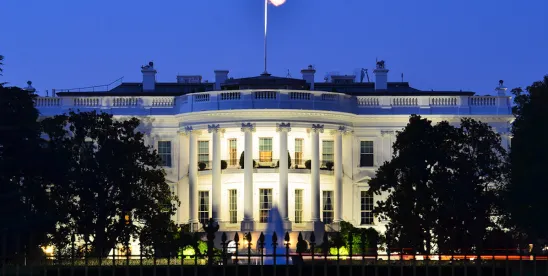Amidst a blitz of executive action, on February 18, President Donald Trump signed an executive order entitled “Ensuring Accountability for all Agencies” (Executive Order) exerting more direct control over “independent regulatory agencies.” President Trump cited the “often-considerable authority” of these independent regulatory agencies as the rationale for needing this additional supervision and control. Furthermore, due to perceived congressional inaction, the Executive Order, coupled with previous ones,[1] forms another part of President Trump’s deregulatory agenda and his efforts to have the executive speak with one voice.
Among other things, the Executive Order requires independent regulatory agencies to submit draft regulations and strategic plans to the president and the Office of Management and Budget (OMB) for review. Additionally, OMB will review independent regulatory agencies’ actions for consistency with the president’s policies and these agencies must establish a White House Liaison to presumably report to the president, although the duties of this position are not defined.
This post sets forth more details on the requirements of the Executive Order, highlights its potential impacts for independent agency regulation and discusses whether the Executive Order could be subject to challenge.
Requirements of the Executive Order
The Executive Order requires all independent regulatory agencies to submit for review all proposed and final significant regulatory actions to the Office of Information and Regulatory Affairs (OIRA) within OMB before publication in the Federal Register. Broadening agencies subjected to regulatory review, the Executive Order references the definition of “independent regulatory agency” from 44 U.S.C. § 3502(5), which includes the Commodity Futures Trading Commission (CFTC) and Securities and Exchange Commission (SEC), among 20 total agencies and a catchall provision to include any other similar agency designated by statute as a federal independent agency or commission.[2] There is a carveout for the Board of Governors of the Federal Reserve System and the Federal Open Market Committee regarding actions related to monetary policy. OIRA currently engages in a limited review of proposed and final rules by independent regulatory agencies. The Executive Order expands the scope of OIRA’s review.
- OMB Establishment of Performance Standards and Management Objectives
The Executive Order empowers the director of OMB to provide guidance on the Executive Order’s implementation and how independent regulatory agencies should structure their submissions. The deadline for these agencies to submit their regulatory actions is either 60 days from the Executive Order or upon completion of the OMB guidance.
- OMB Review of Independent Regulatory Agencies’ Activities and Spending
Pursuant to the Executive Order, OMB will continually review independent regulatory agencies’ obligations for consistency with the president’s policies and priorities. The review process will enable the president to make possible adjustments to agency operations and regulatory actions. For example, OMB review could be used to steer independent regulatory agencies to prohibit or limit spending on particular activities, functions, or projects to the extent that such prohibition or limitation is consistent with US law.
- Additional Coordination and Consultation With the Executive Office of the President
The Executive Order requires independent regulatory agency chairpersons to regularly consult with and coordinate policies and priorities with OMB directors, the White House Domestic Policy Council and the White House National Economic Council. There is no further detail on how often these meetings are expected to occur. Additionally, the Executive Order requires each agency to have a White House Liaison, who will presumably shepherd the communications between the agency and the president.
This requirement is a divergence from precedent as no longer can chairpersons set their own strategic plans; they must submit their agency strategic plans developed pursuant to the Government Performance and Results Act of 1993 to the director of OMB for clearance prior to finalization.
- Centralizing All Executive Branch Interpretations of the Law
Under Section 7 of the Executive Order, the president and attorney general will set forth all official executive branch interpretations of the law. Executive branch employees including agency general counsel, when acting in their official capacity, are prohibited from presenting any legal interpretation as the official position of the United States if it conflicts with the legal opinions of the president or the attorney general. This restriction applies to all actions, including issuing regulations, providing guidance and advocating positions in litigation.
This level of coordination and determination already occurs when, for example, a case is pending before the Supreme Court and the Department of Justice seeks the views of independent regulatory agencies in determining the government’s litigation position before the court. The Executive Order suggests that such coordination will potentially expand to include agency positions taken before district and appellate courts, as well as legal positions taken as part of an agency's rulemaking. It may also slow the pace of regulatory and enforcement action of independent regulatory agencies to account for the additional time to engage with other parts of the executive.
Possible Court Challenge?
Congressional statutes grant the president authority to issue executive orders to help them implement federal laws. Article II of the Constitution prohibits the president from making laws; the president has authority only to enforce and implement laws. When an executive order is written too broadly, it can be found, in certain situations, to be seen as the president exercising legislative powers that are strictly reserved for Congress.
Federal courts have the authority to strike down presidential executive orders for two reasons: (1) where the president lacks authority to issue the order; and (2) the order is prima facie unconstitutional in substance. In the past, executive orders have been challenged via statutory and constitutional grounds.[3] However, federal courts have been cautious to overstep into the powers of another branch.
The Executive Order’s directive regarding independent regulatory agencies is unprecedented because past presidents have explicitly excluded these agencies from similar oversight. For example, President Reagan’s Executive Order 12291 and President Clinton’s Executive Order 12866 both required regulatory review for certain agencies but notably exempted independent regulatory agencies from most of these mandates.[4]
Impact on Independent Regulatory Agencies
Historically, even though the president appoints the commissioners, the CFTC and SEC have operated with some degree of autonomy from the president. This aligns with how independent regulatory agencies were conceived by Congress; to have some protection from direct presidential control. The Executive Order seeks to more directly influence the regulatory agenda of independent agencies.
Indeed, President Trump is asserting broad powers to remove Senate-confirmed members of multimember boards. President Trump has removed members of the National Labor Relations Board (NLRB) and the Equal Employment Opportunity Commission (EEOC). The Supreme Court has recently found that other limitations on the president’s removal power violate the Constitution. In a 2020 case, Seila Law LLC v. CFPB, the Court found that the limitations on the president’s ability to remove the director of the Consumer Financial Protection Bureau (CFPB) violated the Constitution’s separation of powers. In that case, the Court did not explicitly address removal protections for multimember commissions like the CFTC and SEC. Although last year the Supreme Court denied certiorari on a case regarding the Consumer Product Safety Commission (CPSC) that raised these issues, it may get another opportunity based on President Trump’s recent actions. The outcome of such a case could have a significant impact on the president’s ability to directly control independent regulatory agencies.
In the meantime, the Executive Order and the president’s agenda may increase the president’s influence on enforcement actions and investigations, as independent regulatory agencies could give additional weight to broader presidential policies in their decisions to prosecute civil wrongdoing or pursue investigations. This new dynamic may prompt registrants to closely monitor new executive orders to anticipate shifts in enforcement priorities.
As independent regulatory agencies oversee self-regulatory organizations (SROs), such as the SEC and Financial Industry Regulatory Authority (FINRA), changes in agency priorities could affect SRO operations. Although SROs typically focus on technical and operational matters, an independent regulatory agency’s shift to align its policies with the president’s agenda may introduce political considerations into market regulations that were previously apolitical.
An independent regulatory agency’s programs and initiatives that are misaligned with the president’s policies face additional risk under the Executive Order for reduced funding or elimination. As these activities become more visible to the Trump administration, they may face increased scrutiny, potentially impacting budgeting and long-term planning.
Conclusion
The Executive Order’s purpose of expanding presidential oversight over independent regulatory agencies raises several legal questions. The Executive Order contemplates additional interaction between independent regulatory agencies and OMB, with an increased emphasis on implementing the president’s priorities. The Executive Order, along with the anticipated litigation over the president’s removal power, may serve to reshape the relationship between independent regulatory agencies and the president.
Footnotes
[1] UNLEASHING PROSPERITY THROUGH DEREGULATION, The White House (Jan. 31, 2025), https://www.whitehouse.gov/fact-sheets/2025/01/fact-sheet-president-donald-j-trump-launches-massive-10-to-1-deregulation-initiative/.
[2] “Independent regulatory agency” includes the following: the Board of Governors of the Federal Reserve System, the Commodity Futures Trading Commission, the Consumer Product Safety Commission, the Federal Communications Commission, the Federal Deposit Insurance Corporation, the Federal Energy Regulatory Commission, the Federal Housing Finance Agency, the Federal Maritime Commission, the Federal Trade Commission, the Interstate Commerce Commission, the Mine Enforcement Safety and Health Review Commission, the National Labor Relations Board, the Nuclear Regulatory Commission, the Occupational Safety and Health Review Commission, the Postal Regulatory Commission, the Securities and Exchange Commission, the Bureau of Consumer Financial Protection, the Office of Financial Research, Office of the Comptroller of the Currency, and any other similar agency designated by statute as a Federal independent regulatory agency or commission. 44 U.S.C. § 3502(5).
[3] Federal Judicial Center, Judicial Review of Executive Orders, Fed. Jud. Ctr., https://www.fjc.gov/history/administration/judicial-review-executive-orders (last visited Feb. 23, 2025).
[4] President Reagan’s Executive Order 12291 authorized OIRA to review regulatory actions of Cabinet departments and independent agencies, excluding independent regulatory agencies, requiring cost-benefit analyses for major rules. President Clinton’s Executive Order 12866, replacing it in 1993, maintained the exclusion of independent regulatory agencies and narrowed OIRA’s review to specific rule types. See Exec. Order No. 12,291, 3 C.F.R. 127 (1981), reprinted as amended in 5 U.S.C. § 601 app. at 431 (1982) and Exec. Order No. 12,866, 3 C.F.R. 638 (1994), reprinted as amended in 5 U.S.C. § 601 app. at 557 (1994).





 />i
/>i

